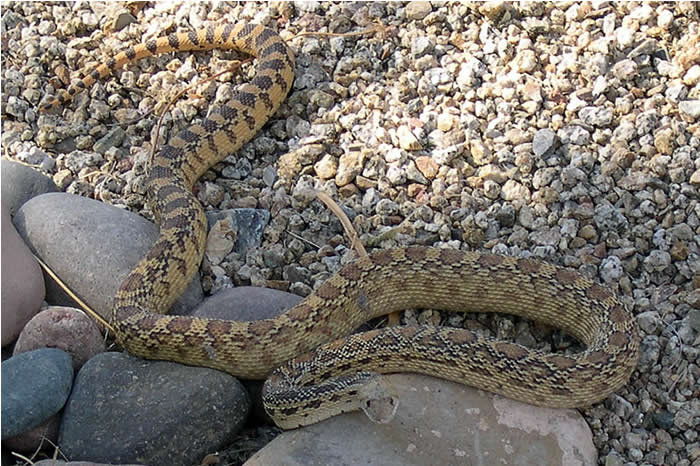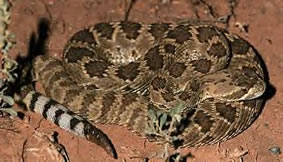Crotalus atrox
Western Diamondback
|
||||||
|
| There are many varieties of
snakes in the Phoenix area, some of which are venomous and
some which are not. The snakes that are the most dangerous
to you in Arizona are the Western Diamondback Rattlesnake, the Mohave Rattlesnake
and the Arizona Coral
Snake. You are most likely to meet up with a
rattlesnake on a summer evening after the sun has gone
down, or during the warm days of spring. How do I tell if a snake is a rattlesnake? You can look for the flat, triangular-shaped head. Many are colored in tan and brown, but not all. The best way to know if you have come across a rattlesnake is if you can see or hear a rattler on the end of its tail. Be aware that young rattlesnakes may not have fully developed rattlers, and so they might have only a few segment and not make any noise. There are seventeen types of rattlesnakes in Arizona. The most common is the Western Diamondback rattlesnake. This snake is the largest of any of the Arizona rattlesnakes, and most bites are attributed to this species. They can grow to over five feet in length, but it is rare to see one that large that is not in captivity. They have alternating equal black and white ringed tail. Not quite as common is the Mohave rattlesnake. The venom can affect the brain or spinal cord. The Mohave is usually very green in color and has alternating white and black bands at the base of the tail with the white twice as wide as the black. Rattlesnakes have two retractable fangs that quickly spring into action when they are attacking their prey. Typical prey includes birds, rodents, rabbits, lizards and amphibians. Generally, they will attack humans only when their territory has been encroached upon, or when they have been provoked. There are more than 70 types of snakes that call Arizona home. But not to worry, most people live their entire lives in Arizona and never see even one. What should I do if I'm bitten by a rattlesnake? Go to a hospital immediately. If you cannot get to a hospital, call Arizona Poison Control Center at 1-800-362-0101 immediately. Don't cut open the wound and try to suck out the venom. That could cause more harm than good. Here's what you should really do. Look for symptoms. If the area of the bite begins to swell and change color, the snake was probably poisonous. Keep the bitten area still. You can immobilize the area with an improvised splint made from a board, magazines, or other stiff material tied to the limb. Don't tie it too tight---you don't want to reduce blood flow. Remove any jewelry or constricting items near the affected area in case of swelling. Keep the area of the snake bite lower than the heart. Tips: If bitten by a rattlesnake
For more info on snakes, see this website. |
Arizona’s other Snakes
|
| Back to the Homepage |



